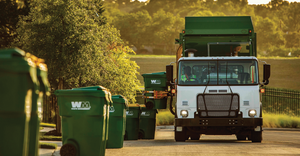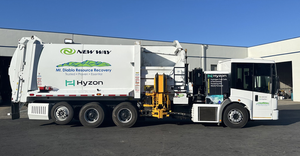The Influence of Bad Habits and Solid Waste Industry Myths on Safety Performance
A long-time industry leader says the overall approach to improving safety in the waste and recycling industry is inadequate.
Dr. Baylor has spent more than 20 years in the solid waste industry working for some of the industry’s leading companies, including Waste Management, Republic Services and, most recently, Progressive Waste Solutions. In that capacity, Baylor has viewed up close how the industry has tackled safety—efforts he views as inadequate given the current rates of fatalities, injuries and turnover among its workforce. In addition, he sees its field management as woefully underdeveloped. In this piece, Baylor argues for a sea change in how the industry handles safety. Waste360 welcomes any response or feedback to this piece. Please leave any feedback in the comment section below or email them to [email protected].
Several years ago, a sports commentator suggested to Bill Parcells, the legendary Hall of Fame football coach, that maybe his team was better than their mediocre record would indicate. Without hesitation, Parcells insisted that, “You are what your record says you are.” By that measure, the solid waste industry stinks at safety.
The occupation of refuse and recycling collector remains the fifth most dangerous in the country. Those who claim to be champions of safety are clearly exaggerating about the effectiveness of their work. There have been far too many preventable fatalities, injuries and accidents.
Most disturbing, for example, are OSHA reports demonstrating that our industry’s fatality rate is still trending upward when overall trucking is going down! By the end of 2015 alone, we were involved in 74 fatal incidents. Further, OSHA reports that our industry’s recordable injury rate is the second highest in the land and way ahead of the comparisons, save construction.
It is well past the time to stop making excuses and look beyond regulatory compliance programs to establish safe work environments for all of our people as well as the communities they so proudly serve. Enough of the long-term plans; let’s do it now!

The State of Things
To be sure, safety is an organizational commitment, not a cost item. It does not happen by simply hiring more technical professionals to manipulate statistics. Indeed, it is difficult to find consensus on the interpretation of events that make up the statistics. (Quite frankly, I would advocate for people with an operations orientation to partner with the technoids to jointly lead any safety initiative.)
Currently, we push lackluster Safety Monday memos with pedestrian content that rarely sees the light of day. Valuable resources are being spent chasing obscure legislative efforts to urge the public to slow down when passing our equipment while very little, if anything, is being done to inform the public about their responsibility.
Adding fancy postings of tragic accidents around cluttered bulletin boards and handing out cutesy bracelets with the safety slogan of the day just doesn’t get it done. Nor will disingenuous executive proclamations trumpeting that “safety is our culture” when employees experience something entirely different every day.
All too often, rudimentary communications are delivered to distracted employees in uncomfortable settings by untrained supervisors in order to document minimal regulatory communications standards.
These are defensive plays that will never be enough. Human resources (HR) departments must abandon their constant urge to form yet another inexperienced committee to revise employee handbooks (that no one ever reads) with even greater threats of discipline for violations, to instead focus on better hiring practices, training and talent retention.
Those who claim that certain equipment (e.g., rear load trucks) is largely to blame, are wrong, and would probably also argue that spoons make people fat. We point the finger at everything and everybody else except the inconvenient truth about our own behavior and the counter-productive operational practices that constitute our industry’s outdated culture.
In the balance is an industry with notoriously underdeveloped management struggling to fill good jobs that regularly turn over in droves. A clarion call to action on those two issues alone would go a long way to improving safety, as well as the bottom line.

The Wrong Work Environment and Too High Turnover
A safe work environment has many facets. A rush-rush-rush mentality is not one of them. Authentic leadership, genuine organizational commitment, strict regulatory compliance, clear performance standards, the right equipment in good working condition, attention to human factors, training with assured learning and conscientiousness are just a few of the essential ingredients.
There are no “silver bullets.” Outcomes are determined by the consistent quality of our cumulative actions. Small details and momentary lapses can be game changers. In our line of work, there is no substitute for everyday mental and physical fitness for duty. None of this is anything new. It’s just hard to find in one place, and that’s a big problem. Especially where, as here, getting the trash up as quickly and cheaply as possible seems to be foremost in determining operational excellence.
The factors that adversely influence and undermine safety in our industry are not unique. Indeed, they are commonplace. So common, in fact, that we fail to recognize them as bad habits or myths. Consider the matter of excessive voluntary employee turnover. This menace to any operation strains every aspect of the business, yet very little has been done to address this massive industry issue largely attributable to counter-productive working conditions.
Many still think that an expedited hiring process is the answer; just get more recruiters to hire faster! It’s not. All too often, people with little or no regard for safety slip by in the rush and get the job. Other employers over rely on temporary employee services to source permanent hires. That’s a lazy approach with poor results, at best. The solution is to apply the same rigor to employee selection that you would any other important business function.
You must do everything possible to get hiring right in the first place. Start by spreading the word that we have great jobs available! By all means, don’t leave it to the HR administrators; get the field operators directly involved. The reason teams win national championships is that they recruit well and put the best players on the field. You can’t go to the derby on a donkey!
Fatigue
Fatigue is a major contributor to unsafe work environments. The mental and physical demands of our work must be met in any weather on roads laced with inconsiderate and distracted citizenry. Scheduling or consistently pushing people to the upper end (or more) of DOT compliance for hours of service in a week is not conducive to safety. Nor is it cost effective. The literature is well settled that employees perform better when they are afforded legitimate breaks during the workday and given two consecutive days off each week.
This is particularly so for those who are exposed to more nocturnal hours of work. Automated equipment may provide some physical relief, but it does little or nothing for the mental strain. The introduction of intimidating technology can be just as stressful and distracting to those who enter the cab with marginal literacy skills in the first place. Throw in a bad night’s rest and a few personal problems weighing on one’s mind and you have a formula for disaster. Daily evaluations of fitness for duty must go beyond alcohol and substance abuse. Provide information on good personal health and wellness habits. If you’re unfit, you must sit!

The Problem With Incentive Pay
Compensation in the solid waste industry has long been a dog’s breakfast. Thus, we have wholesale violations of the first rule of employee relations: “Don’t mess with my paycheck.” (Rule #2 is, “See Rule #1.”) Out of market pay rates, internal disparity and failures to pay for all hours worked are not hard to find. If that’s not bad enough, there is a myriad of complicated incentive compensation schemes that never, ever lived up to their promise.
Well-settled management doctrine dating back more than 100 years confirms that these failed attempts at pop-behaviorism simply do not work. Yet, there are still those among us who mistakenly embrace the misguided notion that once an incentive pay scheme is implemented, productivity and morale skyrockets. Even more so if you call it “productivity pay,” then safety and customer service improves, too.
Baloney!
The only way to cut significant time off of a well-designed route is by sheer luck. All variables are either fixed or uncontrollable. Further, too many union campaigns began with lost trust and confidence surrounding incentive compensation schemes. Too many employees interpret the plans as a mandate to rush and cut corners in a manner that mediates against safety and customer service. Others soon figure out that they can make more money with less aggravation by riding the clock rather than trying to meet arbitrary incentive targets.
Moreover, field management will confide that the administrative aspects of such plans distract them from far more meaningful work (e.g., safety and service), which is especially frustrating to them since they don’t believe in the cruel hoax perpetuated by the incentive schemes, either. The solution is to hire right, pay a fair market competitive hourly rate for all hours worked, set reasonable performance expectations and make darn sure to include working safely in accord with high service standards.
Get away from trying to mask weak supervision with silly pay-for-performance gimmicks that unnecessarily increase costs and undermine business objectives. Instead, invest in teaching your leadership team how to work smarter.

Proper Maintenance
Having the right tools and equipment in reasonably good working order every day is a key contributor to safety. Consider the stress and frustration that comes into play when our computers act up in our cozy, climate-controlled offices during normal business hours. Then imagine the driver who reports for duty in the wee hours only to find that last night’s maintenance request was unfulfilled and the truck was deemed “good enough” for the day.
The spares are in service, and the shop is full. That kind of starts the day off on the left foot. Tension mounts as he encounters inclement weather, heavy traffic, distracted drivers, service obstacles, a few cranky customers and a snippy supervisor. To add insult to injury, at midday he’s directed to hurry up and finish so he can help a co-worker complete a different route … again. Unfortunately, too many people do not see the problem with this scenario, and it’s adverse impact on a safety culture.
We would not tolerate an airline pilot minimizing an illuminated caution light. Nor would we allow a loved one to operate a vehicle in questionable operating condition, let alone operate it well beyond the regular schedule. But, scenes like this play out each day in our industry. Is it any wonder why employees scoff when management proclaims, “safety first?”
Safety Meetings That Matter
Finally, let’s get rid of the tired and worn out practice of conducting mundane safety meetings in cramped settings where an uninspiring supervisor awkwardly regurgitates canned talking points so they can tick the box on corporate and regulatory compliance.
It would be far better to have someone come fully prepared to engage the participants in a two-way discussion so they may share their experiences and learn from others. Use audio, visual and kinesthetic methods. Select capable and credible employees to lead inclusive peer-to-peer sessions. Find a way to make every discussion memorable. And, save the distracting snacks and donuts for after the session.
Safety All the Time
Safety is not a sometime thing; it’s an all the time (often inconvenient) thing. It’s a habit, not a “program” or source of slick, feel-good talking points for senior managers. From an operational standpoint, safety must trump all other interests. After all, what good is jamming productivity if you lose the gains to extraordinary risk management costs? Safety, service, operational efficiency and profitability are not concepts that are mutually exclusive. The cases are legion that support this point. You can have it all. It just may not be the way you’ve always done it. That’s a good thing; obviously past practice in the solid waste industry has failed.
In sum, the solid waste industry must adopt a far greater sense of urgency to address this critical issue. Talking in terms of three- to five-year plans is ridiculous. This is not a new and novel issue. We know what needs to be done. The simple question is: are we going to keep flapping our lips and hope it happens, or are we going to make it happen, right now?
As an old ball coach once said to me, “You kick a thoroughbred in the ass and it runs; you kick a donkey and it kicks back. We’ll see which one we are.”
Dr. Kenneth M. Baylor is the principal at Advanced Leadership Solutions and may be reached at 941.323.8756 or [email protected]. He is an expert in leadership and organizational behavior, which has also established him as a highly regarded keynote and seminar speaker on a wide variety of leadership topics at professional and academic conferences nationwide. His significant industry contributions have been recognized with the National Waste and Recycling Association’s Distinguished Service Award and the Solid Waste Association of North America’s Robert L. Lawrence Lecturer Award. Dr. Baylor’s publications include his peer-reviewed empirical research on the influence of job satisfaction factors and affective commitment on turnover in the solid waste industry.
About the Author
You May Also Like


